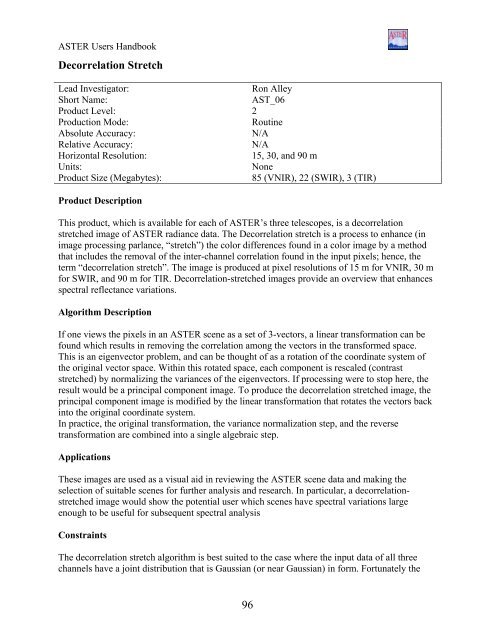You also want an ePaper? Increase the reach of your titles
YUMPU automatically turns print PDFs into web optimized ePapers that Google loves.
<strong>ASTER</strong> Users HandbookDecorrelation StretchLead Investigator:Ron AlleyShort Name:AST_06Product Level: 2Production Mode:RoutineAbsolute Accuracy:N/ARelative Accuracy:N/AHorizontal Resolution:15, 30, and 90 mUnits:NoneProduct Size (Megabytes):85 (VNIR), 22 (SWIR), 3 (TIR)Product DescriptionThis product, which is available for each of <strong>ASTER</strong>’s three telescopes, is a decorrelationstretched image of <strong>ASTER</strong> radiance data. The Decorrelation stretch is a process to enhance (inimage processing parlance, “stretch”) the color differences found in a color image by a methodthat includes the removal of the inter-channel correlation found in the input pixels; hence, theterm “decorrelation stretch”. The image is produced at pixel resolutions of 15 m for VNIR, 30 mfor SWIR, and 90 m for TIR. Decorrelation-stretched images provide an overview that enhancesspectral reflectance variations.Algorithm DescriptionIf one views the pixels in an <strong>ASTER</strong> scene as a set of 3-vectors, a linear transformation can befound which results in removing the correlation among the vectors in the transformed space.This is an eigenvector problem, and can be thought of as a rotation of the coordinate system ofthe original vector space. Within this rotated space, each component is rescaled (contraststretched) by normalizing the variances of the eigenvectors. If processing were to stop here, theresult would be a principal component image. To produce the decorrelation stretched image, theprincipal component image is modified by the linear transformation that rotates the vectors backinto the original coordinate system.In practice, the original transformation, the variance normalization step, and the reversetransformation are combined into a single algebraic step.ApplicationsThese images are used as a visual aid in reviewing the <strong>ASTER</strong> scene data and making theselection of suitable scenes for further analysis and research. In particular, a decorrelationstretchedimage would show the potential user which scenes have spectral variations largeenough to be useful for subsequent spectral analysisConstraintsThe decorrelation stretch algorithm is best suited to the case where the input data of all threechannels have a joint distribution that is Gaussian (or near Gaussian) in form. Fortunately the96















